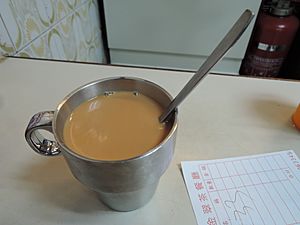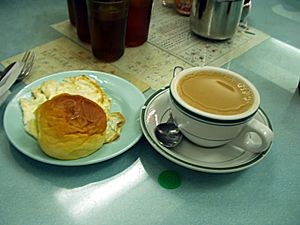Hong Kong-style milk tea facts for kids

Hot milk tea
|
|
| Course | Drink |
|---|---|
| Place of origin | Hong Kong |
| Serving temperature | Hot or iced |
| Main ingredients | Ceylon tea, Black tea, evaporated, condensed milk, sugar |
| Similar dishes | |
Hong Kong-style milk tea is a popular drink from Hong Kong. It's made with black tea (often Ceylon tea) and milk. People usually use evaporated milk or condensed milk. This creamy tea is a big part of Hong Kong tea culture, especially during lunch.
People in Hong Kong drink about 900 million cups of this tea every year! You can find it in restaurants around the world that serve Hong Kong cuisine. In 2012, a TV show called Top Eat 100 said it was the 4th most popular food or drink in Hong Kong. The special way this tea is made is even listed as an important cultural heritage of Hong Kong.
Contents
History of Hong Kong Milk Tea
Hong Kong-style milk tea started when Hong Kong was under British colonial rule. The British loved their afternoon tea, which was black tea with milk and sugar. This idea became very popular in Hong Kong. Hong Kong milk tea is similar, but it uses evaporated or condensed milk instead of fresh milk.
A famous restaurant called Lan Fong Yuen (蘭芳園) says its owner, Mr. Lam, invented both "silk-stocking milk tea" and "Yuenyeung" in 1952. The claim for "silk-stocking milk tea" is even written in official government records from 2007.
This drink is called "milk tea" (Chinese: 奶茶; Cantonese Yale: náaihchà) to tell it apart from "Chinese tea" (Chinese: 茶; Cantonese Yale: chà), which is served plain. Outside of Hong Kong, it's known as "Hong Kong-style milk tea." It also has a fun nickname: "silk stocking milk tea." This name comes from the special cloth bag used to filter the tea leaves. In the 1950s and 1960s, many workers drank this tea. They thought the tea filter bag looked like a lady's pantyhose!
Cultural Heritage of Milk Tea
In 2017, the Hong Kong government officially recognized the "Hong Kong-style milk tea making technique." They added it to the list of Hong Kong's important cultural traditions. This means the special way of making this tea is a valuable part of Hong Kong's heritage. It's like a special skill passed down through generations.
How Hong Kong Milk Tea is Made
Hong Kong-style milk tea is made from a mix of different black teas. Often, Ceylon tea is used, and sometimes even pu'er tea. The tea is mixed with evaporated milk and sugar. Customers usually add the sugar themselves, unless they get it to go. Many tea shops keep their exact tea mix a secret!
A special version called Cha jau (Chinese: 茶走) uses condensed milk instead of evaporated milk and sugar. This makes the tea taste even richer and creamier. Some cafes might also use a mix of skim milk and soybean oil.
The most important part of making Hong Kong-style milk tea is using a special cloth bag to filter the tea leaves. This bag is often called a "sackcloth bag." While other filters can be used, these bags are usually preferred. The bag helps make the tea super smooth. Over time, the bag turns a deep brown color from the tea. Because of its shape and color, it looks like a silk stocking. This is why the tea got its famous nickname: "pantyhose" or "silk stocking" milk tea (Chinese: 絲襪奶茶; Cantonese Yale: sī maht náaihchà). This nickname is mostly used in Hong Kong.
There's a friendly debate about the best way to make milk tea. Some people think you should add the milk before the tea. Others believe the tea should go in first. But for most people, both ways are perfectly fine!
Milk tea is a big part of daily life for many people in Hong Kong. It's often served with afternoon tea, but also at breakfast or dinner. It's as common in Hong Kong as coffee is in Western countries.
You won't usually find milk tea in traditional Chinese restaurants. But it's a standard drink in Hong Kong-style Western restaurants and cha chaan teng (Hong Kong-style diners). You can also find it at Hong Kong's old-fashioned dai pai dong food stalls. A hot cup usually costs about HKD$12–16. A cold cup costs a few dollars more. Hot milk tea is often served in a ceramic cup, a tall glass, or a metal cup.
A good cup of milk tea is known for its "smoothness" (香滑). This means it's very creamy and full-bodied. Another sign of tasty milk tea is a bit of white foam left on the inside of the cup after you drink some. This foam shows that the evaporated milk used has enough butterfat. Some locals also look for a hint of oil on top of the drink. This oil comes from the tea leaves during their roasting process.
Varieties of Hong Kong Milk Tea
Iced milk tea is usually made with ice cubes. But in the past, when ice machines were rare, hot milk tea was poured into a glass bottle and then chilled in a refrigerator. Back then, milk tea was even sold in old Vitasoy or Coca-Cola bottles! Today, "bottle milk tea" is not common in Hong Kong. However, you can find iced milk tea in cans or plastic bottles at many convenience stores like 7-Eleven and Circle K.
When you use ice cubes, they melt and can make the tea taste weaker. To avoid this, some cha chaan tengs serve "ice-less" iced milk tea. They pour hot milk tea into a plastic cup and then cool it in a refrigerator. Or, they place the tea cup into a cold water bath. This is called "ice bath milk tea" (Chinese: 冰鎮奶茶; Cantonese Yale: Bīngjan náaihchà). Some restaurants even use ice cubes made from frozen milk tea itself! These special ways of serving iced tea are often used to attract customers.
A popular mix of milk tea and coffee is called Yuenyeung (Chinese: 鴛鴦; Cantonese Yale: Yūnyēung). There's also a "silk stocking coffee" which is a variation of the "silk stocking tea."
See also
 In Spanish: Té con leche al estilo de Hong Kong para niños
In Spanish: Té con leche al estilo de Hong Kong para niños



